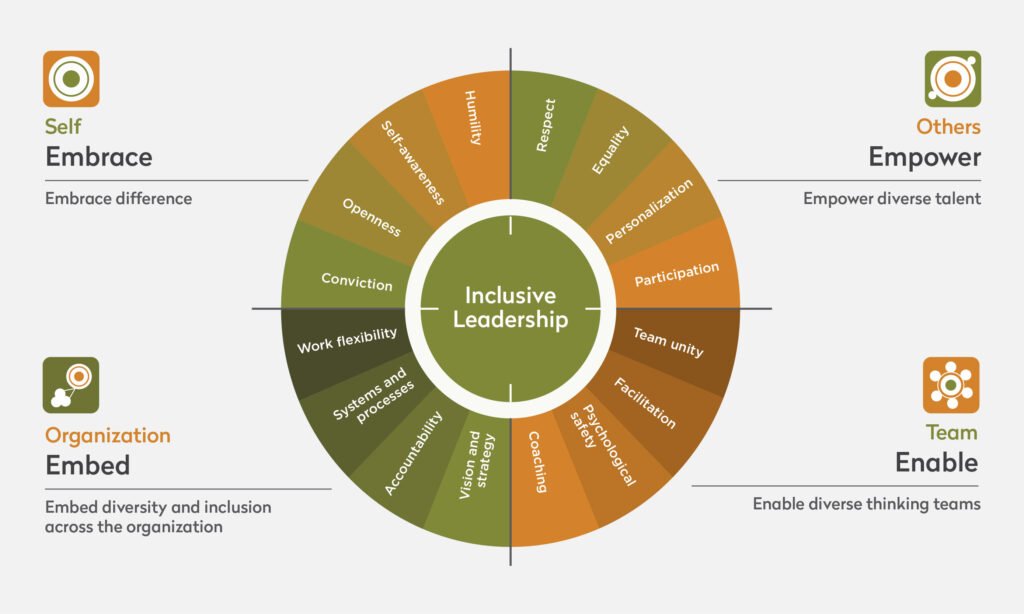Inclusive leadership is not a destination. It’s a journey that requires humility, courage and curiosity. – Thais Compoint
At the start of the pandemic, it became clear that organizations must be more inclusive to change. As the world moves to adopt newer practices, what your company needs is a leader who can work with change.
For successful leadership inclusivity is required. Changes at workplaces due to COVID-19 have helped organizations reset team dynamics. The change helps find more inclusive practices and effective leadership skills.
We would like to point out that anyone can be an inclusive leader. Leading by example shows an inclusive mindset. Strive to achieve remarkable outcomes and help grow the culture of inclusion in the team. Here are some ways in which you can be an inclusive leader. Take a look.
Contents
- 1 What is the definition of inclusive leadership?
- 2 How to be a successful inclusive leader?
- 2.1 Build relationships
- 2.2 Recognition
- 2.3 Be Empathetic
- 2.4 Encourage participation
- 2.5 Alignment
- 2.6 Inclusive Leadership Framework
- 2.7 Inclusive leadership and communication
- 2.8 Goals of an inclusive leader
- 2.9 Leading with equality
- 2.10 Creating bonds with everyone
- 2.11 Fairness in growth
- 2.12 Inclusive leadership training
What is the definition of inclusive leadership?
Here are a few traits that will help you determine if you’re an inclusive leader. As an inclusive leader, you should value employees and allow for different perspectives. You guide people to feel like their contributions have caused an improvement.
An inclusive leader ensures that you treat your team well and have a sense of belonging and value. You provide them with support to perform to their fullest potential.
How to be a successful inclusive leader?
Build relationships
It’s best to not have transactional relationships. That holds good at an organisation level as well. You must invest in building relationships that matter.
Understanding what matters to them and how they want to succeed is important. Look beyond deliverables. It’s not about tolerating the person’s competence level. Building relationships go far beyond that. Inclusive leaders get the importance of recognizing and appreciating who they are.
Recognition
Everyone deserves recognition for their efforts. As an inclusive leader, take time to understand your co-workers’ efforts and growth. This means addressing their unique contributions. It motivates and elevates their sense of personal accomplishment.
Value your employees by supporting them. Let them know their skills and experience have value. An employee’s sense of belonging can increase if they know they are being appreciated.
This enables others to follow suit. Your employees will understand the range of a person’s contribution. A simple thank you, a token of appreciation, or verbal praise — goes a long way.
Be Empathetic
Being warm, encouraging and empathetic can go a long way. Create a space that is inclusive and requires you to appreciate where others come from.
Learn to understand their standpoint and what they might be going through. Be compassionate as it will help foster deep connections with one and all. Make an effort to stay connected as it helps us understand the problems that employees face. Your team will feel valued, seen, and respected.
When in a position of power, be empathetic and model non-judgmental behaviour. It helps everyone feel like they can share their experiences and state of mind. This behaviour reduces tension, keeps stress at bay, and builds stronger relationships.
Encourage participation
When you feel included, you feel more encouraged to take part. This helps in getting people who don’t usually speak up, to engage as well.
Inclusive leaders use an approach where they seek input from one and all. Or check in on people and talk to them about what drives them to succeed. They work on obstacles that hinder participation.
Alignment
An inclusive leader ensures employees have their plans aligned with them to provide their best work. Inclusion means being able to do your best. Leaders who are inclusive share a vision with others and often guide them with clarity.
It’s what sets up your employees for success. You create areas for contribution and gain larger outcomes. It’s great if your employees align with your goals and purpose. But if they don’t, it’s okay. Being an inclusive leader, you should make space for people to find their own meaning and purpose.
When working in an organisation, an employee can decide how best they want to contribute. Creative and innovative solutions can motivate them to think outside the box.
Inclusive Leadership Framework
Below is a helpful framework that can help develop a plan for inclusive leadership.

Inclusive leadership and communication
When leaders are inclusive, it shows in company productivity. Personalising their communication for an audience is important. They should be able to put their audiences first and adapt messages to their needs and interests.
Other than this, inclusive leaders should be knowledgeable. Leaders who are inclusive have a good command of the language and are subject matter experts. They refer to various researches and prove the ability to delve into different views.
Goals of an inclusive leader
Sounds silly to have a goal as an inclusive leader, right? You may think the only goal of an inclusive leader is to be inclusive, but that’s where you are mistaken.
It takes practice, respect, and reflection on the part of leaders to practice these goals. It’s important to understand that it is part of a learning curve.
Make mistakes, create opportunities for equal education and move ahead with positivity.
Leading with equality
What is life without equality, you would ask? But is it surprising to know that being inclusive is a rare trait. So as far as a goal goes, it’s important to strive to integrate equality. Keep equality in your mind in every business decision and relationship. Leading by example often helps as you can influence the culture around us. By prioritising equality, you’ll ensure it’s added to your goals and vision for your company.
Being inclusive and having diversity in a workplace often go hand-in-hand. Try executing inclusive hiring processes into your recruiting strategy.
Creating bonds with everyone
Celebrate and create bonds with everyone in a team. This will help bring on inclusivity. Your employees can follow your example of leadership. Be mindful of the way your team bonds as well. Often, we leave people out because of the nature or time of the social activity.
Example- it can be hard for caregivers to attend a happy hour versus a lunch event. This is because they have childcare obligations. An activity involving playing a sport, can be isolating to those with physical disabilities.
To ensure you include all your employees, consider an activity that suits everyone in your team.
Fairness in growth
This is an important goal. An inclusive leader strives to be fair when it comes to promotions and equality. Being fair and practising equality impacts the bottom line in any workplace.
McKinsey found that companies in the top quartile for gender diversity on their executive teams are now 21% more likely to experience more profitability. Those in the top quartile for ethnic diversity were 33% more likely.
Diversity at all levels isn’t the right thing to do, it’s also the smart thing. Doing assignments without thought impacts inclusion. It’s only natural for bias to trickle down. Sometimes high-value assignments find their way to the same people without realising it. It’s natural that these will affect a promotion.
When promoting, its ideal to do the following:
- Spread High-Visibility Projects: Aim to give all members of the team equal opportunity to step up. Ask yourself, “Are the same people on my team getting important projects over and over?”
- Consider Your Promotions: Did everyone have an equal opportunity? Were all candidates evaluated in a fair manner?
- Share the Promotion Process: Is your promotion process transparent? Do people know what it takes to get promoted? Are professional development conversations taking place all year-round?
Inclusive leadership training
Of course, it isn’t natural for everyone to be an inclusive leader. This is why it’s essential to send your employees to inclusive leadership training. You can choose a program according to what you want to teach your employees.
Power Up and SALT are programs designed to help teach leadership. It helps employees align with the vision and values of their organisation. You will need this information to help meet the goals of any organisation.
Managers will not achieve results if those skills and capabilities are unattended. Providing leaders with training for inclusive leadership will bring them closer to reaching organisational goals.
Having an inclusive leadership framework not only make leaders more effective. They also unlock the potential of teams . They benefit the company in many ways. Achieving these goals requires proper thought-out and targeted action.
Leaders should reflect on what might be holding them back and encourage their teams to do the same. Everyone at a workplace helps in building a more inclusive working environment.
Leaders are remembered for how they behave and treat others during stressful times. Individuals and organisations that get it right will have an advantage regardless of what the future holds.
Hope you found this post helpful. We’d love to hear your thoughts.


